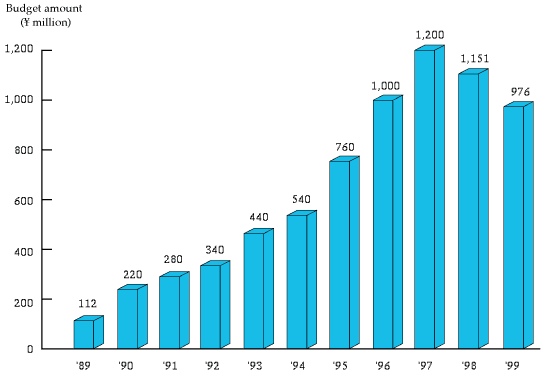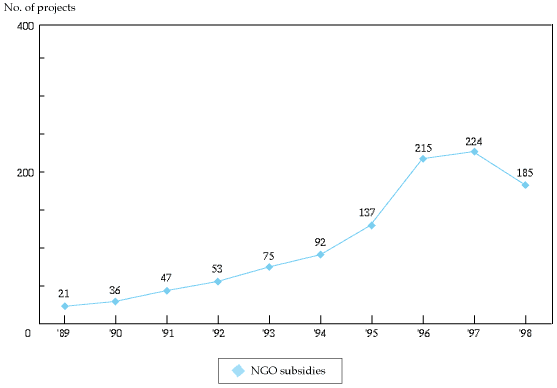Official Development Assistance (ODA)
Part II. Recent Efforts through ODA
Chapter 1 Approaching New Challenges
Section 1 Efforts to Heighten Public Understanding, Support, and Participation
2. Grant Assistance for Grassroots Projects
2.1 Outline of the Scheme and Its Objectives
Japan's grant assistance for grassroots projects (GGP) serves as a framework for financial assistance to economic and social development projects implemented by NGOs, local governments, and research and medical institutions that take an active part in developing countries. Managed primarily by Japanese overseas diplomatic missions, GGP was commenced in FY1989 as "small-scale grant assistance."
Before the scheme was introduced, Japanese grant aid had been limited to the inter-governmental level. However, significant diplomatic successes enjoyed by the other major donor countries through similar small-scale grant assistance schemes led the government to launch its own GGP scheme with high expectations that it would allow Japanese overseas diplomatic missions familiar with local conditions to make swift and well-tailored assistance for relatively small-scale projects.
TOPICS 1. Japanese NGOs' Activities to Assist Kosovar Returnees
Box 1 NGO Subsidy Framework: Changes over the Last Decade
Chart 9 Self-Financed NGO Cooperation from DAC Countries
| Rank | Country | NGO grant (A) | ODA (B) | Ratio (A:B) | |
|---|---|---|---|---|---|
| 1 | United States | 2,518 | 6,878 | 1: | 2.7 |
| 2 | Germany | 948 | 5,857 | 1: | 6.2 |
| 3 | United Kingdom | 313 | 3,433 | 1: | 11.0 |
| 4 | Japan | 223 | 9,358 | 1: | 42.0 |
| 5 | Canada | 175 | 2,045 | 1: | 11.7 |
| 6 | Australia | 151 | 1,061 | 1: | 7.0 |
| 7 | Spain | 123 | 1,234 | 1: | 10.0 |
| 8 | Norway | 121 | 1,306 | 1: | 10.8 |
| 9 | Switzerland | 60 | 911 | 1: | 15.2 |
| 10 | Ireland | 56 | 187 | 1: | 3.3 |
| 11 | Italy | 41 | 1,266 | 1: | 30.9 |
| 12 | Belgium | 40 | 764 | 1: | 19.1 |
| 13 | Austria | 33 | 527 | 1: | 16.0 |
| 14 | Denmark | 29 | 1,637 | 1: | 56.4 |
| 15 | Sweden | 27 | 1,731 | 1: | 64.1 |
| 16 | New Zealand | 15 | 154 | 1: | 10.3 |
| 17 | Finland | 10 | 379 | 1: | 37.9 |
| 18 | Luxemburg | 6 | 95 | 1: | 15.8 |
| 19 | Portugal | 4 | 250 | 1: | 62.5 |
| Netherlands | -267 | 2,947 | - | ||
| France | - | 6,307 | - | ||
| Total | DAC Countries total | 4,628 | 48,324 | 1: | 10.4 |
Source:1998 "DAC Development Cooperation"
- Note:
- NGO grant indicates capital flows for development cooperation projects self-financed by NGOs.
2.2 Expansion of the GGP Program
In principle, GGP funding is under ¥10 million per project. Despite its relatively small scale, the scheme itself has earned high marks in general for its ability to make finely tuned responses to the varied needs at the grassroots level. It should be pointed out, moreover, that the government has steadily expanded the GGP budget scale through the decade to date in order to satisfy the growth of these needs. Though the initial program budget was ¥300 million in FY1989, by FY1995, when the scheme was renamed "grant assistance for grassroots projects", that budget had grown to ¥3 billion. By FY1998, the tenth year since the program's inauguration, the budget was ¥5.7 billion. Also, whereas the number of projects funded was 95 in FY1989, this has expanded steadily to reach 1,064 in FY1998.
The number of countries eligible for GGP funding has also continued to expand over the last decade, increasing from 32 countries in FY1989 to 93 countries and one region (the Palestine Interim Self-Government Authority) in FY1998.
By region, most funding flowed into Asia, followed by Africa and Latin America.
The majority of grants go to NGOs (in FY1998, around 55 percent of the total value disbursed under the scheme), in particular to local NGOs (43 percent, ideal). Significant disbursements are also made to local governments (21 percent) and education and research institutions (15 percent) in developing countries. Japanese NGOs receive around 4 percent.
2.3 Diversification of Funded Project Areas
The largest share of GGP funding goes to projects in the education and research fields (around 39 percent of the total amount disbursed in FY1998), such as the construction and repair of elementary school classrooms. This is followed by projects in the fields of health and medical care (28 percent) and social infrastructure and environment (24 percent). The former include the provision of medical equipment for hospitals, hospital ward construction and improvement of mother and child health care, while well construction to provide drinking water, assistance for the handicapped and environment protection are examples of the latter.
Demand for GGP funding has continued to diversify. For some years now, as noted in Box 3, the government has actively extended such funding for projects in micro-credit, antipersonnel mine clearance and mine victims rehabilitation assistance, resource recycling, and a variety of other new fields.
2.4 Future Issues
Grant assistance for grassroots projects has been well-received at home and abroad over the last decade as a scheme finely-tuned to meet the needs of local inhabitants at the grassroots level. Certain adjustments will be necessary, however, if the program is to continue to meet the diverse and growing needs of developing countries.
While every project funded through the GGP scheme is small in scale, in terms of project numbers, they accounted for 70 percent of all Japanese grant aid projects in FY1998. Further, unlike inter-governmental grant aid, GGP is a scheme managed primarily by Japanese overseas diplomatic missions. It is therefore essential to "equip" better these diplomatic missions in order to sustain the effectiveness and continue to increase the disbursement of grassroots grants in the years ahead. To date, the government has introduced a framework which allows Japanese diplomatic missions to outsource preliminary project studies, project implementation monitoring and project follow-ups to external aid experts. However, further efforts should be made to strengthen project finding and implementation and the monitoring capacity of embassies and general consulates by fostering their direct collaboration with local NGOs.
Box 3 Grassroots Grants Address a Variety of Issues
3. Collaboration with Local Governments and Communities
Local government and community involvement in international cooperation has been promoted chiefly in terms of training programs for recipient country human resources, the deployment of experts abroad, programs of youth exchange, and other ventures at the interpersonal level. Serving as the axis for this cooperation have been friendly or cooperative ties with other countries formed through sister-city and similar relationships, as well as Japanese who have migrated abroad. The drive to merge such activities with ODA has demonstrated effectiveness in providing finely tailored aid as well as heightened opportunities for Japanese citizens to gain hands-on experience in the ODA arena.
JICA has actively pursued closer working ties with local Japanese communities, universities, and private enterprises through its branch offices, international centers, and other outlets nationwide (20 in all). For example, in FY1998, local government offices handled JICA training programs for over 600 foreign technical trainees. Also, some 160 local civil servants were commissioned and sent abroad by JICA on expert assignments. Collaborative projects by JICA and local government offices include the Primary Health Care Project in Nepal, an undertaking in project-type technical cooperation with Saitama Prefecture serving as the domestic implementing agency, and Study on the Environmental Management Plan for the Environmental Model Zone in Dalian Municipality in the People's Republic of China, a development study that the Japanese city of Kita-kyushu has assisted with expertise in the field of urban pollution. Another such project is the Health Improvement Project in Warnes Province, Santa Cruz State in Bolivia, whereby Okinawa Prefecture dispatched a special team of experts to Santa Cruz as assistance from a sister-city. In recent years, this kind of collaboration has been launched right from the planning stage, with JICA working to develop collaborative projects which make optimal use of the distinctive features and technologies of individual local governments in Japan. For example, JICA dispatched survey teams for both the Malawi Participatory Regional Promotion Plan, a scheme incorporating Oita Prefecture's "one village, one item" drive, and the Viet Nam Urban Environment Project, which drew from Tokyo's urban policies.
Working through its community civil service subsidy framework, MoFA provides budgetary assistance to local government level training programs for foreign engineers as well as to programs involving the overseas assignment of local civil servants. In FY1998, approximately ¥1.05 billion in subsidies was provided for programs conducted by the 47 prefectures and six ordinance-designated cities. While this technical cooperation covers an extremely broad spectrum, many of the programs effectively harness the traditional strengths of the participating community: e.g., in such fields reflecting local characteristics as silkworm-raising, tourism, ceramics, plant and animal breeding, the renovation of cultural assets, archaeology and traditional confectionery.
Additionally, to cultivate more human resources experienced in the field of international cooperation at the local community level, JICA has initiated a training program in international cooperation affairs for local civil servants. In FY1998, about 1,000 civil servants took part in that program (including related ventures at the community level). Local communities are also playing a major role in promoting the Japan Overseas Cooperation Volunteer (JOCV) program. Not only are many local civil servants currently involved in the JOCV, for example, but local governments are also lending a hand in JOCV recruitment campaigns. Further, local civil servants are now frequently involved as JOCV coordinators, and have acquired experience as members of Japan disaster relief teams.8
- To assist Turkey in restoring its lifelines following the earthquake disaster that hit in August 1999, Japan sent in an advisory team consisting of 11 civil servants from Kobe City and Hyogo Prefecture who gained experience in lifeline restoration after the Great Hanshin-Awaji Earthquake in 1995. See Section 2, 3. Emergency Aid and Assistance for Relief and Recovery from Natural Disasters.



